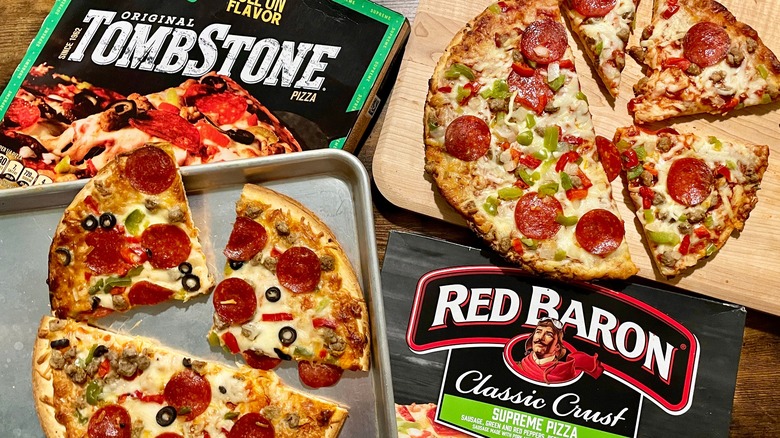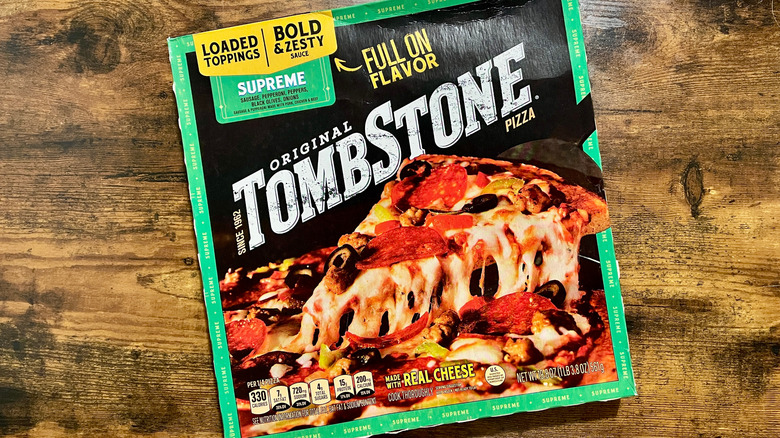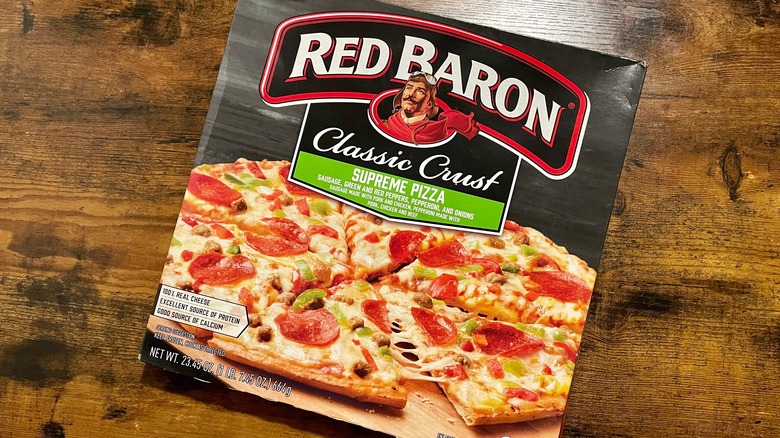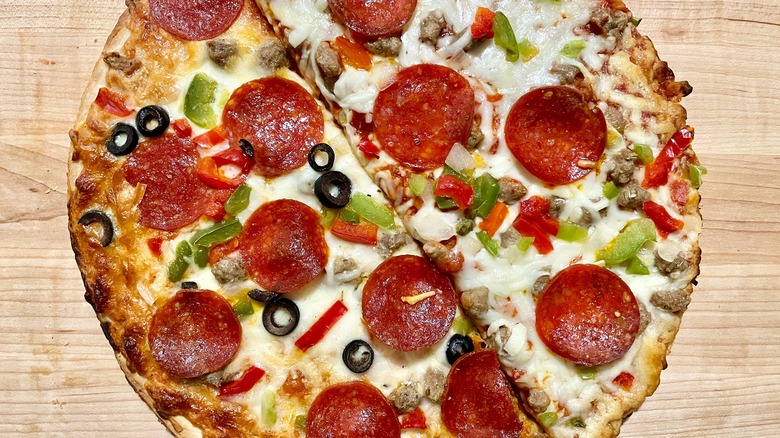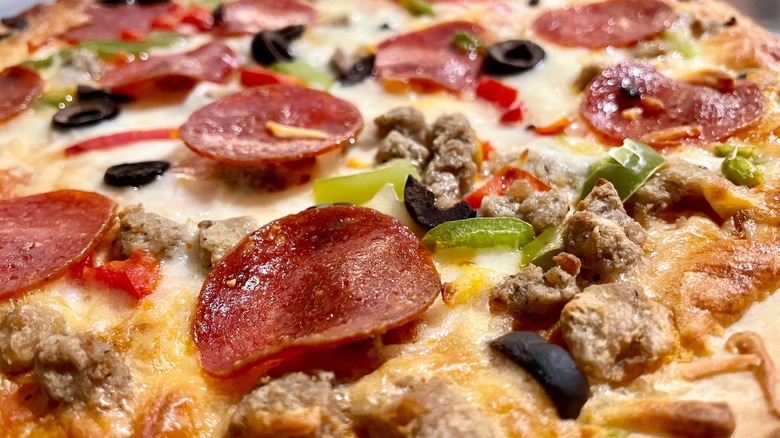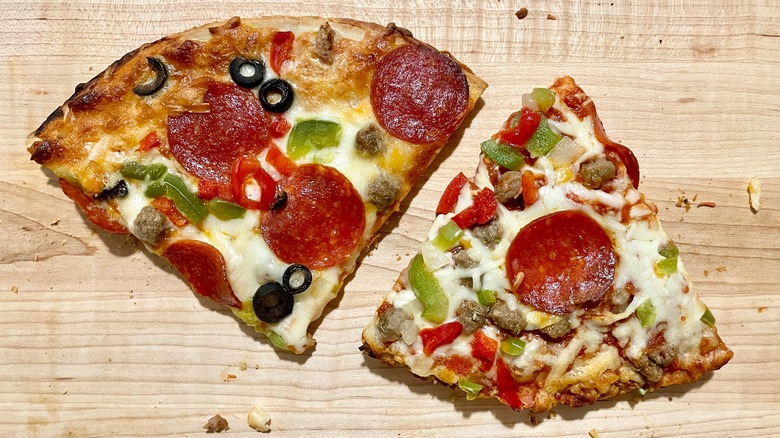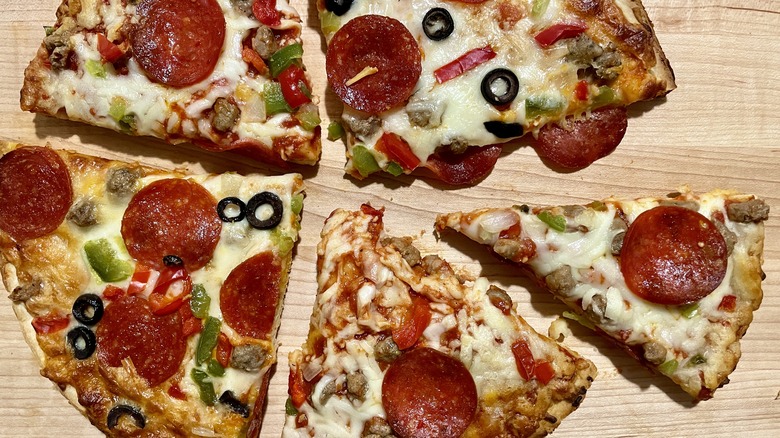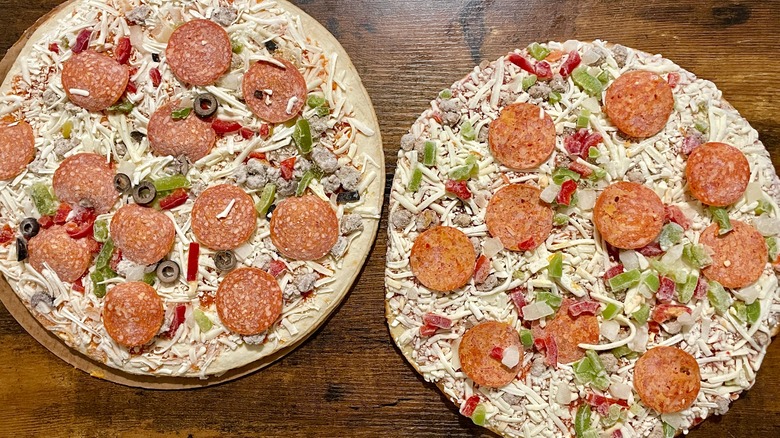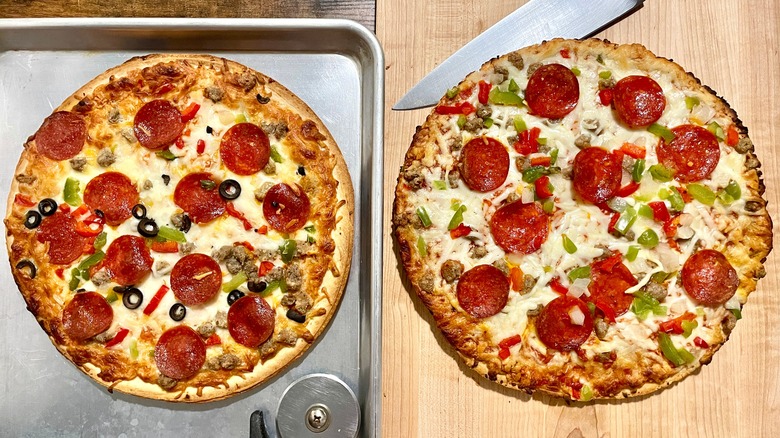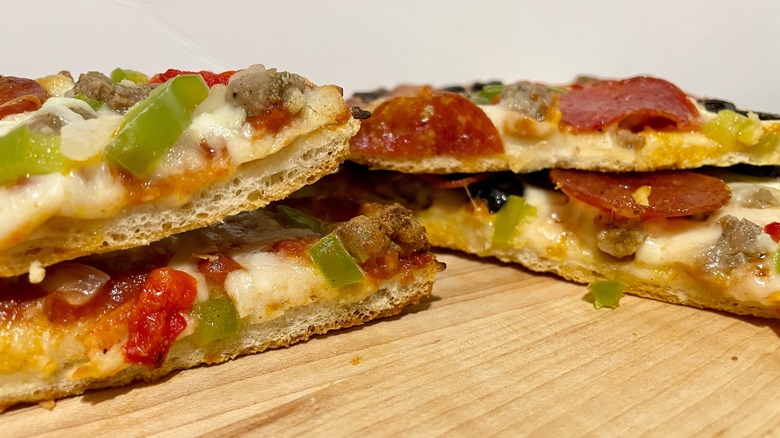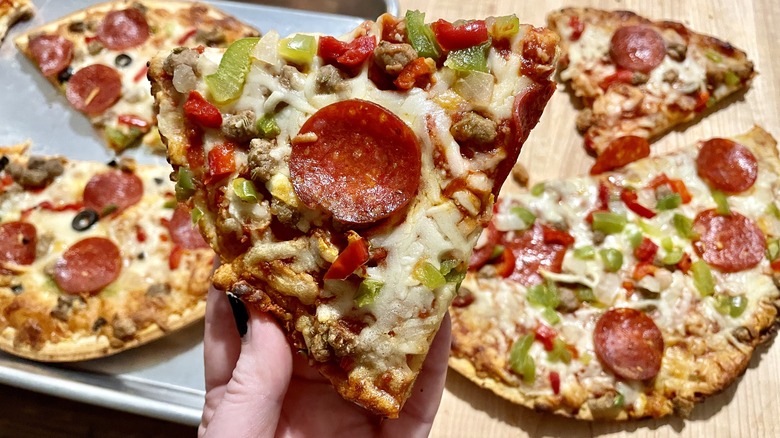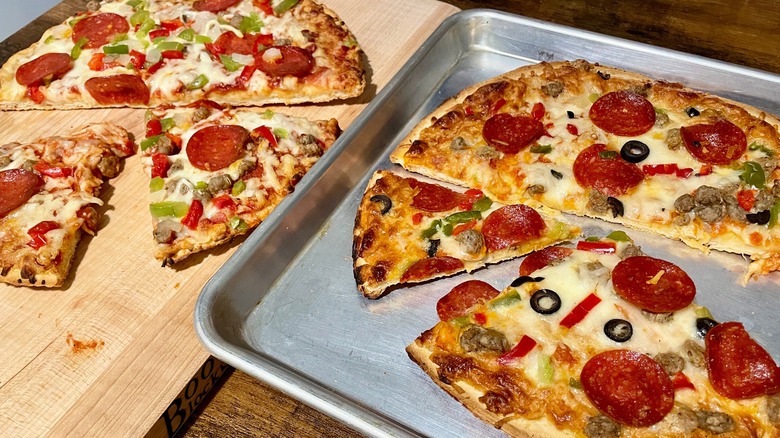Red Baron Vs Tombstone: Which Frozen Supreme Pizza Is The Best?
Given how many options there are for frozen pizzas nowadays, you could spend months eating your way through the freezer section before needing to order out again. But there can be such a thing as too many options, so to help you narrow it down, I've pitted TombStone's Original Thin Crust Supreme pizza against Red Baron's Classic Crust Supreme pizza to see which comes out on top. TombStone and Red Baron are known for their thin-crust pizza options, which are widely available in a variety of flavors.
TombStone pizzas were originally made in a bar — The Tombstone Tap, located across from a graveyard in Medford, Wisconsin — as far back as 1962. But the thin-crust-style pizzas we're all familiar with hit freezers everywhere in 1994, and have been popular with crunchy crust lovers everywhere since. Red Baron pizza made its debut in 1976, produced by Schwan's Food Company, and has remained the company's best selling pizza brand.
I took a look at every aspect of these two thin-crust pizzas, from the size and servings, toppings, ingredients, appearance, cost, cooking instructions, crust, and overall taste, to choose a winner. Here's my honest opinion about which of these popular frozen pizzas is best.
TombStone Supreme Pizzas
TombStone offers two types of supreme pizzas, both in a thin crust style. The Original Thin Crust TombStone pizza comes in 11 flavor combinations, one cheese pizza and 10 with combinations of meats, but only one actual "supreme" pizza in the lineup. For the purpose of this taste test, I chose to stick with the Original Thin Crust Tombstone Supreme pizza, since it's more widely available, and is more indicative of Tombstone's go-to pizza style.
In July 2024, Tombstone also launched a new "Tavern Style" pizza nationwide, touting an extra-thin crust in two flavors: the "Let's Meat Up" pizza that includes pepperoni and pork belly crumble, and "The Primo" pizza, a supreme-style pizza which comes topped with pepperoni, sausage, banana peppers, and red onion. The brand also offers a "Garlic Bread Crust" pizza, but it's currently only offered as a pepperoni pizza. Availability of pizza flavors varies by location, but I was able to find Original Thin Crust TombStone pizzas in pepperoni, 5-cheese, and supreme at several local retailers without an issue.
Red Baron Supreme Pizzas
Red Baron offers a slightly larger selection of supreme pizzas, as well as other topping combinations for those looking for a wider variety to choose from. The Red Baron Classic Crust is also a thin crust-style pizza, which comes in eight flavors and includes two supreme options: Supreme and Special Deluxe. I chose The Red Baron Classic Crust supreme pizza to compare with TombStone's Original Thin Crust supreme pizza, in the name of comparing the original style of each pizza, with no additional frills.
If thin crust pizza isn't exactly your thing, Red Baron also offers a Brick Oven Crust pizza that's a bit more pillowy than the crunchy thin crust variety, and a "Fully Loaded" supreme pizza, which is more of a deep dish crust. Additionally, Red Baron offers supreme pizzas in several of its individually-sized frozen pizza collections, including the Deep Dish Pizza Singles and French Bread Pizzas.
Differences in toppings and cheese
Supreme pizza toppings vary by brand, but generally include several meats and vegetables as toppings. The TombStone Supreme pizza includes sausage, pepperoni, peppers, black olives, and onions. Additionally, the box notes that the sausage and pepperoni are made with pork, chicken, and beef. The front of the box also notes that the pizza is made with "real cheese," and out of curiosity, I took a look at the ingredients to see which cheeses that meant exactly. The ingredients list includes low-moisture part-skim mozzarella as the primary cheese, and much further down on the ingredients list, imitation mozzarella cheese.
The Red Baron Classic Crust Supreme pizza includes sausage, green and red peppers, pepperoni, and onions. The box also notes that the sausage is made from pork and chicken, while the pepperoni is made with pork, chicken, and beef. This supreme pizza also includes "100% real cheese," which is exclusively low-moisture part-skim mozzarella, and doesn't include imitation cheese.
It isn't listed on the front of the TombStone box, but the peppers include both green and red peppers, just like the Red Baron toppings. In fact, the biggest difference in toppings between the two pizzas (aside from the variations in mozzarella cheese) is that the TombStone pizza includes black olives and the Red Baron pizza does not. Depending on your preferences for olives, this may or may not make or break your choice of pizzas.
A closer look at the other pizza ingredients
The ingredients lists for these supreme pizzas are a little dizzying to look at initially. But after sifting through the sub-ingredients listed after each major ingredient, here's what each pizza is essentially made of. The TombStone pizza begins with enriched wheat flour, followed by water, mozzarella cheese, tomato paste, cooked and seasoned pizza topping (the sausage), pepperoni, a vegetable blend (peppers, onions, black olives), imitation mozzarella cheese, and then 2% or less of corn oil, palm oil, sugar, salt, seasoning blend, yeast, and butter flavor. While some of these ingredients might not be the same as what you'd get at an artisanal pizzeria, they are all still relatively common for a pizza.
The Red Baron ingredients list begins with tomatoes, suggesting that the ratio of sauce to dough may be somewhat different with this pizza. Tomatoes are followed by enriched wheat flour, mozzarella cheese, cooked pizza topping (also the sausage), bell peppers, pepperoni, water, onion, and 2% or less of yeast, palm oil, vegetable oil, sugar, salt, modified food starch, spices and seasonings, maltodextrin, hydrolyzed soy and corn protein, dough conditioners, natural flavors, and soy lecithin.
It's unclear whether the ingredients for the Red Baron pizza are actually more complicated, or if they are simply listed in more detail than the ingredients on the TombStone packaging. But strictly for dietary purposes, it's clear that both pizzas contain wheat, milk, and soy and are made with bioengineered food ingredients.
Variations in pizza sizes and servings
When it comes to the size of the pizzas, each measures about 11 inches across and weighs over a pound, but the Red Baron Classic Crust Supreme Pizza weighs a few more ounces than the TombStone Supreme pizza. The Red Baron weighs 1 pound 7.45 ounces, and the TombStone weighs 3.65 ounces less, clocking in at 1 pound 3.8 ounces.
Even though the pizzas are relatively similar in size and weight, the serving sizes for each vary. The Red Baron pizza is theoretically portioned for five slices, with each slice weighing about 133 grams (about 4.7 ounces), with a total of 310 calories per serving. The TombStone pizza, on the other hand, is calculated for four servings per pizza, with each slice weighing 140 grams (about 4.9 ounces) and a total of 330 calories per serving.
Regardless of how you slice your pizza, you're getting a little more pizza with Red Baron by overall weight. But if you're focusing on servings alone, you're getting fewer but slightly more substantial servings with the TombStone pizza. With that said, it would take quite a bit of effort to slice a Red Baron pizza into five semi-equal slices, making for a skewed comparison. When dividing the Red Baron pizza into four normal slices to match the four slices in a TombStone pizza, each slice then weighs 166 grams (about 5.86 ounces) and includes about 387 calories per slice.
Differences in cost at the grocery store versus takeout
Prices for each of these frozen pizzas can be wildly different depending on where you're purchasing them from. For example, at my local grocery store in New York City, the TombStone Original Thin Crust Supreme pizza cost me $8.50, and the Red Baron Classic Crust Supreme pizza cost $8.27, each before tax. But those prices are heavily dependent on location. A quick search online revealed that the very same pizzas were available at a Walmart just across the river in New Jersey for about half the price. There, both the TombStone and the Red Baron pizza retail for $4.82 before tax.
When doing a much broader search, the average price of a TombStone pizza was more likely to land between $5 to $7, while most of the Red Baron pizza options I found were in the lower $4 to $6 range.
In comparison to pizza delivery prices, both the TombStone and Red Baron pizzas are far more economical options — even at the highest end of the price spectrum. For example, a comparable 12-inch thin-crust pizza from Domino's Pizza in my area, made with pepperoni, green peppers, onions, and olives, costs $20.99 before taxes, tip, and any delivery fees. A large thin-crust pizza with the same toppings from Papa John's in my area costs a whopping $30.99 before any promotional price reductions or additional taxes and fees.
Similarities in cooking time and instructions
Both the TombStone and Red Baron Supreme pizzas have similar basic cooking instructions, which involve preheating your oven to 400 degrees Fahrenheit and cooking your frozen pizza directly on the rack of the oven. The cooking instructions for both pizzas specify using the center rack, but the TombStone instructions further specify making sure that the rack is six to eight inches away from the bottom of the oven. At that point, the TombStone pizza gets baked for "20 minutes or until cheese is melted and edges are golden brown." The Red Baron pizza instructions give a time frame of 18 to 21 minutes instead of a single cooking time, but also specifies that you'll know it's done based on the visual cues of melted cheese in the center of the pizza and golden brown edges.
I'll be honest, I've never cooked a pizza directly on the rack of my oven. I'm always afraid that the toppings will slide off, or worse, the pizza will collapse into a burning heap at the bottom of my oven (and I'll just end up ordering the takeout that I was trying to avoid in the first place). Instead, I always reach for a sheet tray or pizza pan to bake it on, and Red Baron has baking instructions for that too. The preheating and center rack placement instructions are the same, but the cooking time range is just a little longer, from 21 to 23 minutes.
Differences in the pizzas' appearance
The most immediately noticeable difference between the TombStone and Red Baron supreme pizzas is that the cheese and toppings on the Red Baron pizza go all the way to the edge of the pizza, whereas the toppings stop about a half of an inch from the edge of the TombStone pizza. But be warned: if you're the kind of person who likes that extra nibble of undressed crust, some of that crust will get obscured by melted cheese in the baking process, but not all of it.
Aside from differences in crust visibility, it was clear from a quick glance that the TombStone pizza had more slices of pepperoni on it than the Red Baron pizza did. Two more slices, to be precise! The TombStone pizza had a full dozen slices of pepperoni, whereas the Red Baron pizza only had ten (yes, I counted).
From looks alone, the only other notable difference between the two pizzas is the inclusion of black olives on the TombStone pizza. The additional pops of black on top gave it a little more visual appeal, along with the flecks of red and green bell peppers.
Comparing the crust and sauce
Before even taking a bite out of the Red Baron pizza, it's clear that the crust has a little more thickness to it. It's not necessarily the same thickness you'd get from an ordinary slice of pizza, but it's not nearly as thin as the TombStone pizza. So it's not surprising when the TombStone pizza crust offers a little more crunch, whereas the Red Baron pizza crust has slightly more chew and tear to it. Both crusts are relatively uniform all the way to the edge of the pizza, without much of a rise at the end, even on the unfinished TombStone crust edge.
Not only does the Red Baron pizza have a slightly more substantial crust, but it's got a clearly defined layer of sauce. The TombStone pizza, on the other hand, has just enough sauce to be noticeable, but most of the sauce blends in with the melted cheese layer without setting itself too far apart.
Final Verdict: More is more with the Red Baron Classic Crust Supreme Pizza
Given how similar each of these supreme pizzas is, I can genuinely say that I wouldn't be disappointed enjoying either one for an easy lunch or dinner. But of the two options, the Red Baron Classic Crust Supreme pizza was my preferred slice, thanks to the additional sauce, slightly thicker crust, and toppings that stretch all the way to the edge of this pizza. Since this isn't the kind of pizza crust that's made to really stand on its own, I don't see the need for a plain edge — more is more here.
But TombStone absolutely deserves credit for making sure there are a full dozen slices of pepperoni in its supreme pizza. Just because the Red Baron pizza is saucier doesn't mean it's okay to skimp on the toppings. I also learned while eating the TombStone pizza that I don't dislike olives on my pizza nearly as much as I thought I did. I enjoyed the olives so much that next time, I might pick up the Red Baron Special Deluxe Pizza, which includes olives, to see how it compares to both of these options.
Those who enjoy a crunchy pizza crust or want to slice a few calories off of their meal without sacrificing any of the good stuff, may prefer the TombStone Original Thin Crust Supreme pizza over the Red Baron. But anyone looking for a fulfilling amount of pizza with the maximum diameter of toppings, sauciness, and flavor should enjoy the Red Baron Classic Crust Supreme pizza.
Tasting Methodology
Since both TombStone and Red Baron offer several styles of supreme pizzas, but both brands' original style is a thin-crust style pizza, I chose to compare the two most similar original style pizzas, which also happen to be the most widely available options. In the name of giving each a fair shot, I baked both side-by-side, directly on the center rack of the oven for about 20 minutes, and tasted both of them as soon as they were cool enough to eat.
Since I knew the difference between the two pizzas before tasting them, I enlisted the help of two other tasters to help point out any differences that I may have missed along the way. Everyone agreed that the crust and sauce put the Red Baron pizza ahead, although one taster liked the flavor of the pepperoni and general toppings of the TombStone pizza better. Two pizzas served three hungry adults, but we all agreed that if only serving two, we'd want the pizza that offers the most bang for our buck, which is the Red Baron pizza.
